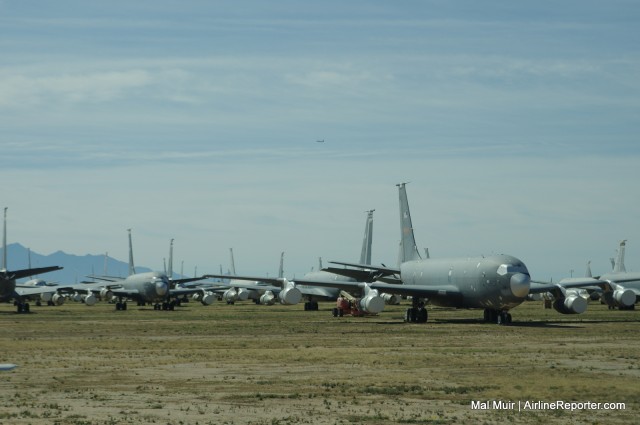
Row after row of KC-135s at AMARG
In my previous piece we talked about how great the Pima Air & Space Museum in Tucson was, and how much of an AvGeek dream it is to walk around. However Pima isn’t the only reason AvGeek’s want to come to Tucson; they also come for the Boneyard.
The Boneyard, or the 309th Aerospace Maintenance And Regeneration Group (AMARG) as it is officially known, belongs to the United States Air Force and is part of Davis Monthan Air Force Base (although technically next door). Most of the aircraft at AMARG have come from the armed forces of the United States. The Army, Navy, Air Force, Marine Corps, and Coast Guard all send their equipment here once it has reached the end of its service life. Some countries, such as Norway, send their military aircraft to AMARG for what this facility does best – storing military aircraft. Before we talk about how you can visit AMARG, we need to talk first about what they do.
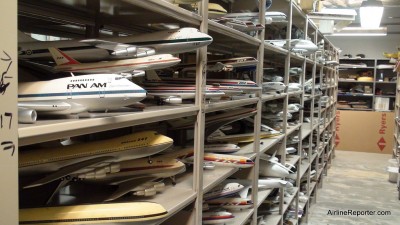
How would you like to have this airline model collection located in the Boeing Archive? Um, yes please.
A while back I had the amazing experience of checking out Boeing’s archive located in Bellevue, WA. My first post in September gave the general overall look at the archives. Unfortunately since then, I got distracted with other things and caused a delay. This post will be going over the models (airplane not people) found in the archives and next week I will be posting my interview with Boeing Historian Michael Lombardi.
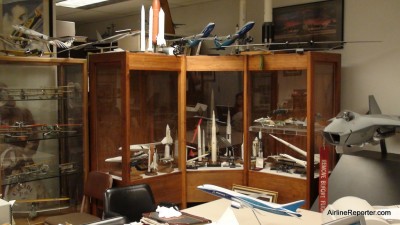
These are just some of the models located in the lobby of the Boeing Archive. They keep the real good ones locked up.
When I went for my visit in September, I was expecting the archives to be a bunch of boxes on shelves. One of the best surprises were all the amazing and unique models housed in the archives. From single aisle Boeing 747 mock ups to Boeing boats, I felt like a kid in a candy store needing a sugar rush. The archive has so many models, it has been difficult to store them all. I told Lombardi that I would be more than happy to store some at my house, but I don’t think that will work out. Although some models were spread around in the lobby and on random shelves, most were stored in two long rows of shelving. There were military and commercial airline models, but of course my main interest were the airliners.
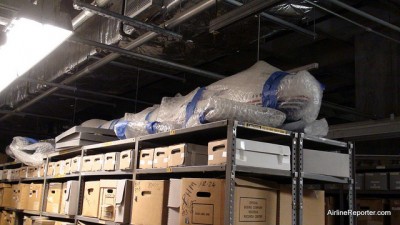
I got so distracted by learning about the Boeing boats, I forgot to take a photos. But I did catch this HUGE Boeing 747 model.
Did you catch I said “Boeing boats” earlier? I am not talking about the Boeing 314 Flying Clipper, I am talking about real boats. Using their knowledge from aerodynamics, Boeing dove into the world of hydrofoil/jetfoil boats. They first launched in 1962 and built boats for military and commercial use until 1988 when Boeing Marine Systems closed and sold the license for the Commercial Jetfoils to Kawasaki Heavy Ind. Lombardi tells me that some Boeing Jetfoils are still “flying” to Macao and between Korea/Japan.
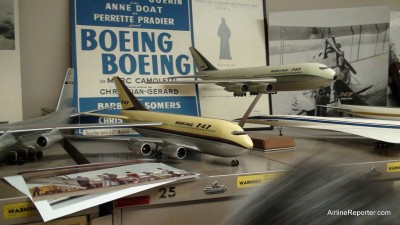
Two single aisle, double deck mock ups for the original Boeing 747.
When Boeing was looking at making a larger aircraft after the Boeing 707, they played with the idea of a double-decker, singled-aisle airplane like these two models depicted above. Can you spot the differences (larger version)? One has the wings in the middle of the fuselage, the other a bit higher. Also check out the differences in landing gears. These models look much more like the Airbus A380 than they do the Boeing 747. You can really see the nose of the Boeing 707/727/737 in the white model. Also, do not miss the Boeing SST model, there were quite a few of those spread out around the archive.
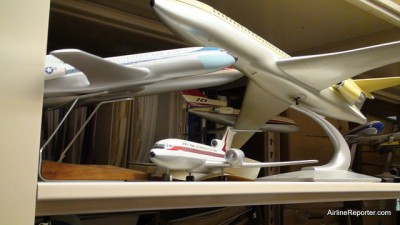
This is one odd-looking potential Boeing 727
This little guy (seen above) was hard to spot amongst all the models, but looked very interesting. Lombardi explained what the function of the engines being placed on the wings. “During the 1970s Boeing studied all aspects of commercial aviation and also reviewed the entire commercial family to see what could be improved. This model of the 727 shows one of those considerations it is a STOL 727 using a concept called USB or upper surface blowing. USB was successfully tested on the Boeing QSRA and the Boeing YC-14.” The Boeing 727 is one of my favorite airliners since it looks so majestic. I don’t think I would have the same love if it looked like the model above or like this other funky looking 727 model.
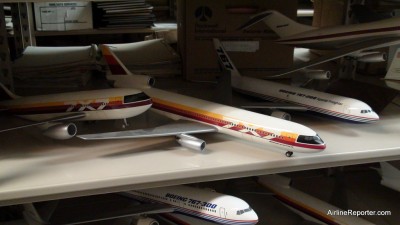
These show what Boeing was looking at with the Boeing 767.
There was a pretty big section of Boeing 767 prototype models in the Boeing archive. There were ones that closely resemble what became the Boeing 767 and others that looked… well, unique. Boeing was playing with the idea of making the 767 being a quad or even tri-jet aircraft. Probably the most interesting Boeing 767 prototype is the one you can see on the right on the photo above and detailed in the photo below.
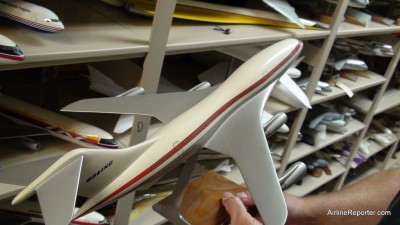
Check out the sweet waistline on this possible Boeing 767 design.
This was one of my favorite models. That slick waist-line shape would have allowed the plane to travel at near sonic speeds. Lombardi explained why it wasn’t chosen. “Much like the Sonic Cruiser and it did not go forward for the same reasons that the Sonic Cruiser did not go forward – the fuel burn increases dramatically at near sonic/transonic speeds because of the increased drag.” I would imagine the seat layout on the interior would have been interesting and a bit cumbersome.
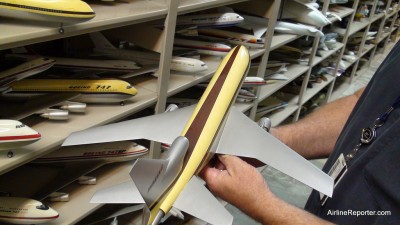
A model of the Boeing 747 Tri-Jet at the archive.
No matter how many times I have seen the mock ups, the Boeing 747 TriJet always looks odd to me. During the 1970’²s Boeing wanted to better compete with the DC-10 and L1011. The Boeing 747SP was too costly to directly compete, so for a short while, Boeing looked at creating a 747 with three jets instead of the standard four. The design has two jets on the wing and one on the tail in an ’œS’ configuration, much like the L1011. The concept was scrapped since it would take too much time, money, and a new wing design.
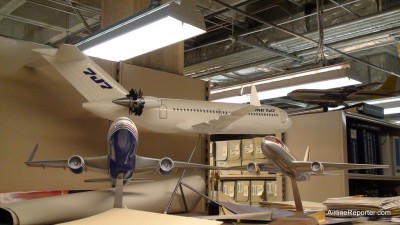
Ah, the Boeing 7J7. Wait a second... is that a Boeing 767 with foldable wings?
The Boeing archive wouldn’t be complete without a model of the Boeing 7J7. This aircraft was designed in the 1980’s with the idea of replacing the Boeing 727. It used Unducted Fan Engines on the rear of the plane that provided superior fuel economy. Boeing hoped the 7J7 would burn about half the fuel of the Airbus A320 and hoped to revolutionize commercial air travel. A reduction in oil prices and noise concerns ended up killing off the 7J7. Might we see another version of the UFE in the future? I am going to bet on yes.
Be sure to take a look at all 44 photos taken of the Boeing archive.
Inside The Boeing Company Archives
PART 1 | PART 2 | PART 3a | PART 3b | ALL PHOTOS | ALL STORIES









